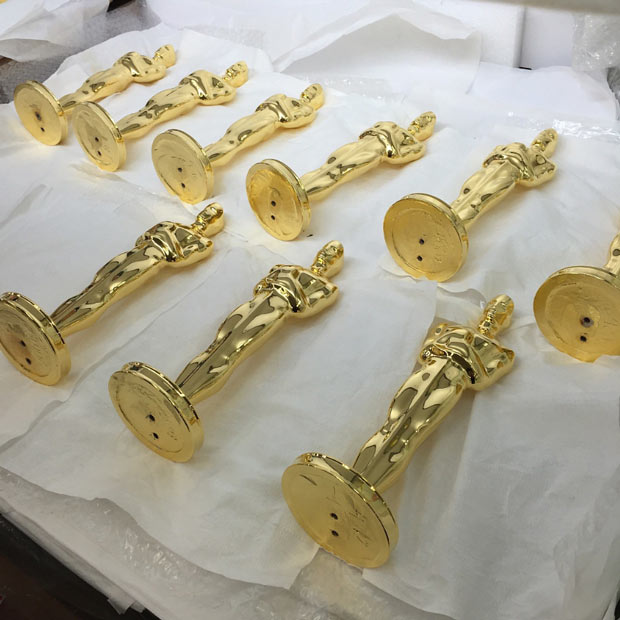
This year’s Oscars are plated in 24-karat Laser Gold. Image courtesy of Epner.
February 25, 2016
The Oscar nominees aren’t the only ones gearing up for the awards ceremony on Sunday—the Academy of Motion Picture Arts and Sciences is working hard to ensure this year’s statuettes are perfectly crafted and polished. This year’s design is created with a mix of 3D printing technology and a layer of Laser Gold.
The Oscar statuette has traditionally been manufactured with molds and metal, but production methods faced deterioration over time. This year, Polich Tallix updated the design by scanning a handful of past awards and the current face. Once a digital design was formed, the company used a casting to combine wax and ceramic slurry. After this production process, Oscar is plated in 24 karat gold. (Editor’s Note: Read more about 3D printing and Oscar on Rapid Ready Tech).
However, this year’s gold is also used on NASA spacecraft. Originally developed by Epner technology, Laser Gold is used by the space agency for its ultra-high infrared reflectivity, which helps maintain thermal control of on-board instruments. It is deposited by electroplating and is three times harder than pure gold, Epner states.
But technology at the Oscars doesn’t just stop at the statuettes themselves; the Academy recognizes scientific and technical achievements.
“Our honorees represent an enormous range of technologies, from camera rigs to software systems, with names as colorful as ‘Biscuit Jr.,’ ‘Barbershop’ and ‘PhysBAM,’” said Richard Edlund, visual effects artist and chair of the Scientific and Technical Awards Committee. “They exemplify the phenomenal creativity of professionals in the scientific and technical community, and the invaluable contributions they make to what is arguably the most creative industry in the world.”
Among this year’s winners are:
- To Michael John Keesling for the design and development of Image Shaker, an optical system that convincingly creates the illusion of the camera shaking in a variable and repeatable manner.
- The Image Shaker was unique and superior to alternatives in use when it was invented two decades ago, and it continues to be used today.
- To David McIntosh, Steve Smith, Mike Branham and Michael Kirilenkofor the engineering and development of the Aircover Inflatables Airwall.
- This system of modular inflatable panels can be erected on location, at lengths reaching hundreds of feet, with exceptional speed and safety. When used to support blue or green screens, the Airwall permits composite shots of unprecedented scale.
- To Trevor Davies, Thomas Wan, Jon Scott Miller, Jared Smith and Matthew Robinson for the development of the Dolby Laboratories PRM Series Reference Color Monitors.
- The PRM’s pioneering and innovative design allows the stable, accurate representation of images with the entire luminance range and color gamut used in contemporary theatrical feature presentation.
The red carpet kicks off at 7 p.m. EST on Feb. 28th, with the all-new 3D-printed Oscar statue making its debut.
Subscribe to our FREE magazine, FREE email newsletters or both!
About the Author
DE’s editors contribute news and new product announcements to Digital Engineering.
Press releases may be sent to them via [email protected].







